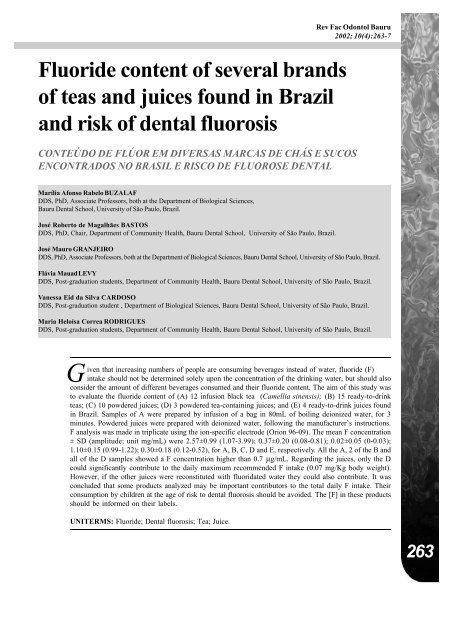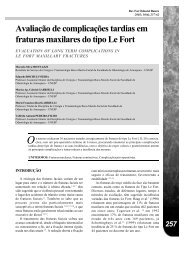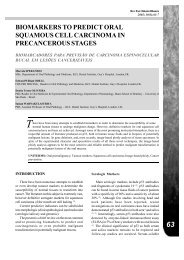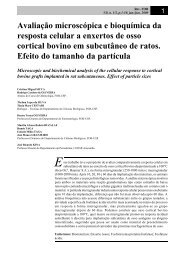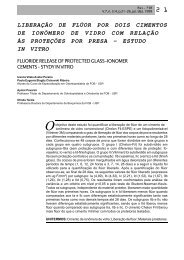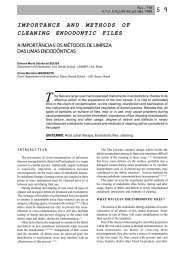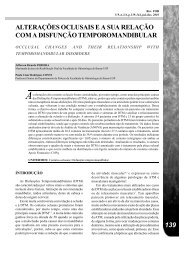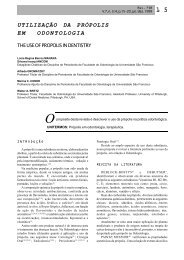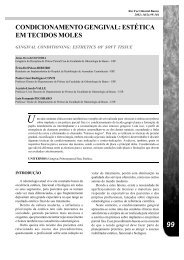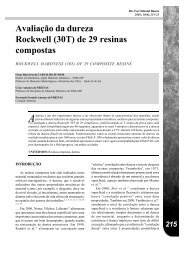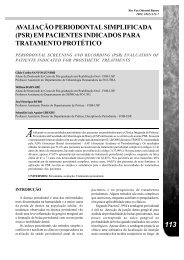Fluoride content of several brands of teas and juices found in Brazil ...
Fluoride content of several brands of teas and juices found in Brazil ...
Fluoride content of several brands of teas and juices found in Brazil ...
You also want an ePaper? Increase the reach of your titles
YUMPU automatically turns print PDFs into web optimized ePapers that Google loves.
Buzalaf M A R, Bastos J R de M, Granjeiro J M, Levy F M, Cardoso V E da S, Rodrigues, M H CFLUORIDE CONTENT OF SEVERAL BRANDS OF TEAS AND JUICES FOUND IN BRAZILAND RISK OF DENTAL FLUOROSISINTRODUCTIONS<strong>in</strong>ce the 1940’s, the prevalence <strong>of</strong> dentalfluorosis has <strong>in</strong>creased, concomitant with a reduction<strong>in</strong> dental decay. These changes have been attributed<strong>in</strong> part to the widespread use <strong>of</strong> systemic <strong>and</strong> topicalfluorides. Various sources <strong>of</strong> <strong>in</strong>creased systemicfluoride exposure have been <strong>in</strong>vestigated.It has long been accepted that fluorideaccumulates <strong>in</strong> the leaves <strong>of</strong> the tea plant Camellias<strong>in</strong>ensis. In addition it is known that some <strong>of</strong> thisfluoride is released <strong>in</strong>to the <strong>in</strong>fusion, which is drunkas tea. The exact concentration <strong>of</strong> fluoride <strong>in</strong> a cup<strong>of</strong> tea <strong>and</strong> the effects <strong>of</strong> this fluoride have been thesubject <strong>of</strong> many <strong>in</strong>ternational studies 1,4,6,7 .Increas<strong>in</strong>g consumption <strong>of</strong> beverages as areplacement for water has made the fluoride <strong>content</strong><strong>in</strong> beverages an important issue. Few studies have<strong>in</strong>vestigated fluoride exposures from <strong>in</strong>fused tea,<strong>juices</strong> <strong>and</strong> from tea <strong>and</strong> juice-flavored manufactureddr<strong>in</strong>ks. <strong>Fluoride</strong> <strong>in</strong>gestion from these beverages bychildren may be a substantial factor <strong>in</strong> thedevelopment <strong>of</strong> fluorosis. Thus, the aim <strong>of</strong> the presentstudy was to evaluate the fluoride <strong>content</strong> <strong>of</strong> <strong>several</strong><strong>in</strong>fusion <strong>teas</strong>, ready-to-dr<strong>in</strong>k <strong>teas</strong>, powdered <strong>juices</strong>,powdered tea-conta<strong>in</strong><strong>in</strong>g <strong>juices</strong> <strong>and</strong> ready-to-dr<strong>in</strong>kfruit <strong>juices</strong> <strong>found</strong> <strong>in</strong> <strong>Brazil</strong>.MATERIAL AND METHODSSampl<strong>in</strong>gTwelve samples <strong>of</strong> <strong>in</strong>fusion black tea (Camellias<strong>in</strong>ensis - A); 15 samples <strong>of</strong> ready-to-dr<strong>in</strong>k <strong>teas</strong> (B);10 samples <strong>of</strong> powdered <strong>juices</strong> (C); 3 samples <strong>of</strong>powdered tea-conta<strong>in</strong><strong>in</strong>g <strong>juices</strong> (D); <strong>and</strong> 4 samples<strong>of</strong> ready-to-dr<strong>in</strong>k <strong>juices</strong>, from different <strong>br<strong>and</strong>s</strong> (E)(Table 1) were purchased <strong>in</strong> Bauru, São Paulo, <strong>Brazil</strong>.The products were chosen because they are the mostconsumed by <strong>in</strong>fants <strong>and</strong> young children. Br<strong>and</strong>name, food type, flavor, conta<strong>in</strong>er size, batch number,<strong>and</strong> manufacturer’s name were recorded for eachproduct studied (Table 1).TABLE 1 - Teas <strong>and</strong> <strong>juices</strong> analysedBeverage typeProduct name (flavor)ManufacturerProduction siteInfused black teaCastellari (black tea)Leão (black tea)Royal blend (black tea)L<strong>in</strong> Tea (black tea)Oetker (black tea)Apichá (black tea, vanilla,cocconut, almond, tanger<strong>in</strong>e,damask, g<strong>in</strong>seng)Effem BrasilLeão JúniorFleischmann e RoyalUnilever Bestfoods BrasilOetker Produtos AlimentíciosApi-NutriSão Caetano do SulCuritibaJundiaíPouso AlegreSão PauloCamp<strong>in</strong>asMate <strong>and</strong> black ready-todr<strong>in</strong>kice-teaIce tea Lipton (Light peach,diet lemon, peach, lemon)Nestea (peach, lemon)Santal (peach, lemon, redfruits, lemon mate)Leão (peach, diet lemon,natural)Leãoz<strong>in</strong>ho (peach,strawberry)PomarCoca Cola/NestléParmalatLeão JúniorLeão JúniorAraguari/JundiaíRibeirão PretoJundiaíCuritibaAmericanaPowdered juiceSukest (grape,guarana)Frisco (grape)Mid (grape)Fresh (grape, guarana)Suks (grape)Tang (grape)Ki-suco (grape)SukestUnilever Best FoodsAj<strong>in</strong>omotoKraft Foods BrasilSukestKraft Foods BrasilKraft Foods BrasilBauruGoiâniaLimeiraCuritibaBauruCuritibaCuritibaPowderedtea-conta<strong>in</strong><strong>in</strong>g juiceCligth (italian grape)Kraft Foods BrasilCuritiba264Ready-to-dr<strong>in</strong>k juiceCligth (peach, lemon, apple)Del Valle (grape)Del Valle Kids (grape)Santal (grape)Kapo (grape)Kraft Lacta Suchard BrasilSucos Del Valle BrasilSucos Del Valle BrasilParmalatCia. de Bebidas IpirangaSão Paulo/CuritibaAmericanaAmericanaJundiaíRibeirão Preto
Rev Fac Odontol Bauru2002; 10(4):263-7Preparation <strong>and</strong> fluoride analysisThe products were opened on the day <strong>of</strong> theanalysis. The black <strong>teas</strong> were prepared by <strong>in</strong>fusion<strong>of</strong> a bag <strong>in</strong> 80 mL <strong>of</strong> boil<strong>in</strong>g deionized water, for 3m<strong>in</strong>utes. The powdered <strong>juices</strong> were prepared withdeionized water, follow<strong>in</strong>g the manufacturer’s<strong>in</strong>structions.<strong>Fluoride</strong> analysis<strong>Fluoride</strong> was analyzed us<strong>in</strong>g the ion-specificelectrode (Orion Research, Cambridge, MA, USA,model 9609), after sample buffer<strong>in</strong>g with an equalvolume <strong>of</strong> TISAB II. A set <strong>of</strong> st<strong>and</strong>ards (conta<strong>in</strong><strong>in</strong>g0.1, 0.2, 0.4, 0.8 <strong>and</strong> 1.6 ppm fluoride) was prepared,us<strong>in</strong>g serial dilution from a 100 ppm NaF stocksolution (Orion). The millivoltage potentials wereconverted to µg F/mL us<strong>in</strong>g a st<strong>and</strong>ard curve with acoefficient correlation <strong>of</strong> r≥0.992. The meanreproducibility <strong>of</strong> the read<strong>in</strong>gs, based on the triplicatesamples, was 99.4 percent.RESULTSTable 2 shows the F concentration determ<strong>in</strong>edfor all the products. F concentration is expressed asmg/mL. Mean F concentration ± SD (amplitude, n)were 2.57 ± 0.99 (1.07-3.99, n=12), 0.37 ± 0.20(0.08-0.81, n=15), 0.02 ± 0.05 (0-0.03, n=10), 1.10± 0.15 (0.99-1.22, n=3), 0.30 ± 0.18 (0.12-0.52,n=4), for A, B, C, D <strong>and</strong> E, respectively. All the A,2 <strong>of</strong> the B <strong>and</strong> all <strong>of</strong> the D samples showed a Fconcentration higher than 0.7 µg/mL.TABLE 2 - <strong>Fluoride</strong> concentration (g/mL) <strong>of</strong> <strong>teas</strong> <strong>and</strong> <strong>juices</strong>BeveragesF concentration(µg/mL)BeveragesF concentration(µg/mL)Castellari (black tea)*Leão (black tea)*Royal blend (black tea)*L<strong>in</strong>tea (black tea)*Oetker (black tea)*Apichá black tea*Apichá vanilla*Apichá cocconut*Apichá almond*Apichá tanger<strong>in</strong>e*Apichá damask*Apichá g<strong>in</strong>seng*Ice tea Lipton (light peach)**Ice tea Lipton (diet lemon)**Ice tea Lipton (peach)**Ice tea Lipton (lemon)**Nestea (peach)*a*Nestea (lemon)**Santal (peach)**Santal (lemon)**Santal (red fruits)**Santal (lemon mate)**2.941.491.211.072.953.993.123.052.423.373.561.640.260.390.170.190.710.570.240.340.380.10Leão (peach)**Leão (diet lemo)**Leão (natural)**Leãoz<strong>in</strong>ho (peach)**Leãoz<strong>in</strong>ho (strawberry)**Sukest (grape)***Sukest (guarana)***Frisco (grape)***Mid (grape)***Fresh (grape)***Fresh (guarana)***Suks (grape)***Tang (grape)***Ki-suco (grape)***Cligth (italian grape)***Cligth (peach tea)****Cligth (lemon tea)****Cligth (apple tea)****Del Valle (grape)*****Del Valle Kids (grape)*****Santal (grape)*****Kapo (grape)*****0.440.440.430.090.8100.1500000.030000.991.210.980.520.340.200.12*Infusion black tea**Ready-to-dr<strong>in</strong>k <strong>teas</strong>***Powdered <strong>juices</strong>****Powdered tea-conta<strong>in</strong><strong>in</strong>g <strong>juices</strong>*****Ready-to-dr<strong>in</strong>k <strong>juices</strong>265
Buzalaf M A R, Bastos J R de M, Granjeiro J M, Levy F M, Cardoso V E da S, Rodrigues, M H CFLUORIDE CONTENT OF SEVERAL BRANDS OF TEAS AND JUICES FOUND IN BRAZILAND RISK OF DENTAL FLUOROSIS266DISCUSSIONGiven that <strong>in</strong>creas<strong>in</strong>g numbers <strong>of</strong> people areconsum<strong>in</strong>g beverages <strong>in</strong>stead <strong>of</strong> water, fluoride <strong>in</strong>takeshould not be determ<strong>in</strong>ed solely upon theconcentration <strong>of</strong> the dr<strong>in</strong>k<strong>in</strong>g water, but should alsoconsider the amount <strong>of</strong> different beverages consumed<strong>and</strong> their fluoride <strong>content</strong>.Tea <strong>and</strong> <strong>juices</strong> are a pleasant, popular, sociallyaccepted, economical, <strong>and</strong> safe dr<strong>in</strong>k that is enjoyedeveryday by hundreds <strong>of</strong> millions <strong>of</strong> people acrossall cont<strong>in</strong>ents. Tea also provides a dietary source <strong>of</strong>biologically active compounds that help prevent awide variety <strong>of</strong> diseases, <strong>and</strong> either is used as a calm<strong>and</strong> pa<strong>in</strong>killer agent <strong>in</strong> childhood.It is considered that the optimal range <strong>of</strong> fluoride<strong>in</strong>take is 0.05-0.07 mg F/kg body weight/day 1,5 . Most<strong>of</strong> the products we analyzed had high F concentration.All <strong>of</strong> the A, 2 <strong>of</strong> the B <strong>and</strong> all <strong>of</strong> the D samplesshowed a F concentration higher than 0.7 mg/mL.The F concentration <strong>found</strong> <strong>in</strong> A (Table 2) areconsistent with the reports <strong>of</strong> Chan; Koh 3 <strong>and</strong> <strong>of</strong>Pang; Phillips; Bawden 8 , who <strong>found</strong> Fconcentrations between 0.34 <strong>and</strong> 3.71 ppm (<strong>in</strong>caffe<strong>in</strong>ated tea <strong>in</strong>fusions) <strong>and</strong> between 2.00 <strong>and</strong> 3.00ppm, respectively. The F concentrations <strong>in</strong> <strong>juices</strong>(Table 2) are with<strong>in</strong> the same range as those reportedby Pang; Phillips; Bawden 8 (0.1-1.7 ppm), byHe<strong>in</strong>tze; Bastos 6 (0.06 ppm) <strong>and</strong> by Bastos et al. 1(0.1-0.5 ppm or more, be<strong>in</strong>g the highest values forthe guarana <strong>and</strong> grape powdered <strong>juices</strong>).The amount <strong>of</strong> F <strong>in</strong> these products we analyzedsuggests that they may significantly contribute to thedaily fluoride <strong>in</strong>take. For the highest F concentration<strong>found</strong> (black tea Apichá, 3.99 µg F/mL), when only200 mL are consumed just once a day, this mayprovide up to 100% <strong>of</strong> the upper limit <strong>of</strong> the ranges<strong>of</strong> estimates believed to be associated with <strong>in</strong>creasedrisk <strong>of</strong> enamel fluorosis (0.07 mg F/kg body weight/day) for a 2-year-old child, that weighs around 12kg 2,5 , hav<strong>in</strong>g a estimated fluoride <strong>in</strong>take <strong>of</strong> 0.80 mg.In addition, the level <strong>of</strong> fluoride may be much higher,when fluoridated water is used to reconstitute theproduct.For the grape fruit <strong>juices</strong>, the mean Fconcentration <strong>found</strong> were lower than the onereported by Stannard; Shim; Krits<strong>in</strong>eli; Labropoulou;Tsamtsouris 10 , who <strong>found</strong> that 42% <strong>of</strong> the sampleshad more than 1 ppm F. The authors had alreadyobserved that when the <strong>juices</strong> were made with grapesseparated from the sk<strong>in</strong>, they did not conta<strong>in</strong> anyfluoride. S<strong>in</strong>ce it is a common practice to use fluorideconta<strong>in</strong><strong>in</strong>g<strong>in</strong>secticide <strong>in</strong> grow<strong>in</strong>g grapes, it is believedthat contam<strong>in</strong>ation <strong>of</strong> these <strong>juices</strong> occurred. Wash<strong>in</strong>gthe grape sk<strong>in</strong>s also produced appreciable quantities<strong>of</strong> fluoride.This work was carried out <strong>in</strong> an attempt toestablish the significance <strong>of</strong> F <strong>in</strong> tea <strong>and</strong> <strong>juices</strong>,consider<strong>in</strong>g the daily F <strong>in</strong>take. The most popular<strong>teas</strong> <strong>and</strong> <strong>juices</strong> <strong>in</strong> <strong>Brazil</strong> are not readily available <strong>in</strong>other countries <strong>and</strong>, therefore, <strong>Brazil</strong>ian data mightnot be assumed to be similar to those <strong>in</strong> foreignstudies. Despite some researches identify <strong>teas</strong> as acaries preventive agent among schoolchildren 9,13,11 ,future research is needed to def<strong>in</strong>e the actualmagnitude <strong>of</strong> health benefits, establish the safe range<strong>of</strong> tea <strong>and</strong> some <strong>juices</strong> consumption associated withthese benefits, <strong>and</strong> elucidate potential mechanisms<strong>of</strong> action. By identify<strong>in</strong>g potential sources <strong>of</strong> high F<strong>in</strong>gestion, recommendations can be made to reduceconsumption from these sources <strong>in</strong> patients who maybe at risk <strong>of</strong> dental fluorosis. It is recommended thata research project be carried out to analyze thebioavailability <strong>of</strong> F from <strong>teas</strong> <strong>and</strong> <strong>juices</strong> available onthe <strong>Brazil</strong>ian market. 12CONCLUSIONSIt was concluded that some products analyzedmay be important contributors to the total daily F<strong>in</strong>take. Their consumption by children at the age <strong>of</strong>risk to dental fluorosis should be avoided.RESUMOConsider<strong>and</strong>o-se que um gr<strong>and</strong>e número depessoas está consum<strong>in</strong>do bebidas <strong>in</strong>dustrializadas ao<strong>in</strong>vés de água, a <strong>in</strong>gestão de flúor não pode serdeterm<strong>in</strong>ada apenas pela sua concentração na água,devendo-se considerar a diversidade de bebidas<strong>in</strong>dustrializadas consumidas e sua concentração deF. O objetivo deste estudo foi avaliar o conteúdo deflúor em (A) 12 chás pretos para <strong>in</strong>fusão (Camellias<strong>in</strong>ensis); (B) 15 chás <strong>in</strong>dustrializados prontos parao consumo; (C) 10 sucos em pó; (D) 3 sucos em pócontendo chá; e (E) 4 sucos <strong>in</strong>dustrializados prontospara o consumo encontrados no Brasil. As amostrasA foram preparadas por <strong>in</strong>fusão do sachê em 80mLde água deionizada fervente, por 3 m<strong>in</strong>utos. Os sucosem pó foram preparados com água deionizada,segu<strong>in</strong>do as recomendações dos fabricantes. Asanálises do teor de F foram feitas em triplicata como uso de eletrodo íon específico (Orion 96-09). Asconcentrações médias de F ± DP (amplitude; unidade
Rev Fac Odontol Bauru2002; 10(4):263-7mg/mL) foram 2,57±0,99 (1,07-3,99); 0,37±0,20(0,08-0,81); 0,02±0,05 (0-0,03); 1,10±0,15 (0,99-1,22); 0,30±0,18 (0,12-0,52), para A, B, C, D e E,respectivamente. Todas as amostras A, 2 amostrasB e todas as amostras D apresentaram umaconcentração de F maior que 0,7 µg/mL. Para ossucos, apenas os D poderiam contribuirsignificantemente para a <strong>in</strong>gestão diária máxima deF recomendada (0,07 mg/Kg peso). Entretanto, osoutros sucos, se reconstituídos com água fluoretada,também poderão contribuir para a <strong>in</strong>gestão diáriamáxima de F. Concluiu-se que muitos dos produtosanalisados podem ser importantes contribu<strong>in</strong>tes paraa <strong>in</strong>gestão diária total de F, e o seu consumo porcrianças na faixa etária de risco para fluorose dentaldeve ser evitado. A concentração de F presentenestes produtos deveria ser <strong>in</strong>formada em seusrótulos.UNITERMOS: Flúor; Fluorose dental; Chá; Suco.REFERENCES1. Bastos JRM, Figliolia SLC, Levy FM, Buzalaf MAR, SalesPeres SHC, Bastos RS. Conteúdo de flúor observado nos refrescosem pó encontrados no comércio de Bauru – SP. RevInst Ciên Saúde 2000; 18 (2): 123-8.2. Burt BA. The chang<strong>in</strong>g patterns <strong>of</strong> systemic fluoride <strong>in</strong>take.J Dent Res 1992; 71: 1228-37.3. Chan JT, Koh SH. <strong>Fluoride</strong> <strong>content</strong> <strong>in</strong> caffe<strong>in</strong>ated,decaffe<strong>in</strong>ated <strong>and</strong> herbal <strong>teas</strong>. Caries Res 1996; 30 (1): 88-92.6. He<strong>in</strong>tze SD, Bastos JRM. Avaliação do teor de flúor e pHem bebidas no mercado nacional. Rev Ass paul cirurg Dent1996; 50 (4): 339-45.7. Kavanagh D, Renehan J. <strong>Fluoride</strong> <strong>in</strong> tea-its dentalsignificance: a review. J Ir Dent Assoc 1998; 44 (4): 100-5.8. Pang DT, Phillips CL, Bawden, JW. <strong>Fluoride</strong> <strong>in</strong>take frombeverages consumption <strong>in</strong> a sample <strong>of</strong> North Carol<strong>in</strong>a children.J Dent Res 1992; 71 (7): 1382-8.9. Parajas IL. Caries preventive effect <strong>of</strong> wild tea (tsaang-gubat)among school children. J. Philipp Dent Assoc 1995 Dec-1996Feb; 47 (3): 3-13.10. Stannard JG., Shim YS, Krits<strong>in</strong>eli M, Labropoulou P,Tsamtsouris A. <strong>Fluoride</strong> levels <strong>and</strong> fluoride contam<strong>in</strong>ation <strong>of</strong> fruit<strong>juices</strong>. J Cl<strong>in</strong> Pediatr Dent 1991; 16 (1): 38-40.11. Touyz LZ, Amsel R. Anticariogenic effects <strong>of</strong> black tea(Camellia s<strong>in</strong>ensis) <strong>in</strong> caries prone-rats. Qu<strong>in</strong>tessence Int 2001;32 (8): 647-50.12. Trautner K, Siebert G. An experimental study <strong>of</strong> bioavailability<strong>of</strong> fluoride from dietary sources <strong>in</strong> man. Arch OralBiol 1986; 31 (4): 223-8.13. Yue L, Gao X, Dong Y. Effect <strong>of</strong> tea on fluoride <strong>in</strong> plaque<strong>and</strong> saliva. Zhonghua Kou Qiang Yi Xue Za Zhi 1998; 33 (6):355-7.Endereço do autor responsável:Marília Afonso Rabelo BuzalafAl. Dr. Octávio P<strong>in</strong>heiro Brisolla, 9-75Laboratório de BioquímicaBauru-SP - CEP 17012-901Tel: (14) 235-8346e-mail: mbuzalaf@fob.usp.br4. Cury JA. Concentração de fluoreto em chás brasileiros e seusignificado na prevenção de cárie. RGO 1981; 29 (2): 136-8.5. Fomon SJ, Ekstr<strong>and</strong> J, Ziegler EE. <strong>Fluoride</strong> <strong>in</strong>take <strong>and</strong> prevalence<strong>of</strong> dental fluorosis: trends <strong>in</strong> fluoride <strong>in</strong>take with special attention to<strong>in</strong>fants. J Public Health Dent 2000; 60 (3): 131-9.267


